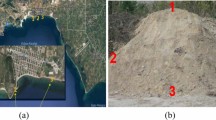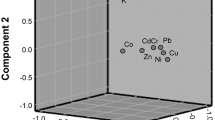Abstract
Radionuclides from the U and Th natural series are present in alkaline rocks, which are used as feedstock in Brazil for the production of raw phosphoric acid, which can be considered as a NORM (naturally occurring radioactive material). As a result of the purification of raw phosphoric acid to food-grade phosphoric acid, two by-products are generated, i.e., solid and liquid wastes. Taking this into account, the main aim of this study was to evaluate the fluxes of natural radionuclide in the production of food-grade phosphoric acids in Brazil, to determine the radiological impact caused by ingestion of food-grade phosphoric acid, and to evaluate the solid waste environmental hazards caused by its application in crop soils. Radiological characterization of raw phosphoric acid, food-grade phosphoric acid, solid waste, and liquid waste was performed by alpha and gamma spectrometry. The 238U, 234U, 226Ra, and 232Th activity concentrations varied depending on the source of raw phosphoric acid. Decreasing radionuclides activity concentrations in raw phosphoric acids used by the producer of the purified phosphoric acid were observed as follows: Tapira (raw phosphoric acid D) > Catalão (raw phosphoric acids B and C) > Cajati (raw phosphoric acid A). The industrial purification process produces a reduction in radionuclide activity concentrations in food-grade phosphoric acid in relation to raw phosphoric acid produced in plant D and single raw phosphoric acid used in recent years. The most common use of food-grade phosphoric acid is in cola soft drinks, with an average consumption in Brazil of 72 l per person per year. Each liter of cola soft drink contains 0.5 ml of food-grade phosphoric acid, which gives an annual average intake of 36 ml of food-grade phosphoric acid per person. Under these conditions, radionuclide intake through consumption of food-grade phosphoric acid per year per person via cola soft drinks is not hazardous to human health in Brazil. Considering these annual additions of 238U, 226Ra, 232Th and 40K, and since these radionuclide should be homogeneously distributed in the upper 10 cm of soils with an assumed apparent density of 1.5 g/cm3, a maximum increase of 0.19 ± 0.03 Bq kg−1 of soil is expected for 238U and 234U. Thus, the addition of solid waste as phosphate fertilizers to Brazilian agricultural soils does not represent a hazard to the ecosystem or to human health.



Similar content being viewed by others
References
Beddow, H., Black, S., & Read, D. (2006). Naturally occurring radioactive material (NORM) from a former phosphoric acid processing plant. Journal of Environmental Radioactivity, 86, 289–312.
Bolívar, J. P., Pérez-Moreno, J. P., Mas, J. L., Martín, J. E., San Miguel, E. G., & García-Tenorio, R. (2009). External radiation assessment in a wet phosphoric acid plant. Applied Radiation and Isotopes, 67(10), 1930–1938.
Conceição, F. T., & Bonotto, D. M. (2003). Use of U-isotope disequilibrium to evaluate the weathering rate and fertilizer-derived uranium in São Paulo State, Brazil. Environmental Geology, 44, 408–418.
Conceição, F. T., & Bonotto, D. M. (2006a). Radionuclides, heavy metals and fluorine incidence at Tapira phosphate rocks, Brazil, and their (by) products. Environmental Pollution, 139, 232–243.
Conceição, F. T., & Bonotto, D. M. (2006b). Distribuição de radionuclídeos, metais pesados e flúor em perfis de alteração nos complexos de Catalão (GO) e Tapira (MG), Brasil. Geochimica Brasiliensis, 20(2), 175–190.
Conceição, F. T., Bonotto, D. M., Jimenez-Rueda, J. R., Oliveira, E. G., Mancini, L. H., Ramiriz, C., et al. (2009a). Radionuclides and other elements distribution in the Catalão I phosphate ore rocks, Brazil, and their (by) products. Geochimica Brasiliensis, 23(2), 241–254.
Conceição, F. T., Bonotto, D. M., Jimenez-Rueda, J. R., & Roveda, J. A. F. (2009b). Distribution of 226Ra, 232Th and 40K in soils and sugar cane crops at Corumbataí River basin, São Paulo State, Brazil. Applied Radiation and Isotopes, 67(7), 1114–1120.
Crockett, G. M., Smith, K. R., Oatway, W. B., & Mobbs, S. F. (2003). Radiological impact on the UK population of industries which use or produce materials containing enhanced levels of naturally occurring radionuclides. Part II: the steel industry (pp. 37–43). National Radiological Protection Board.
El Afifi, E. M., Hilal, M. A., Khalifa, S. M., & Aly, H. F. (2006). Evaluation of U, Th, K and emanation of radon in some NORM and TENORM samples. Radiation Measurements, 41(5), 627–633.
Ferrari, C. C., & Soares, L. M. V. (2003). Concentrações de sódio em bebidas carbonatadas nacionais. Ciência e Tecnologia de Alimentos, 23(3), 414–417.
Health Canada. (1999). Uranium in drinking water, Federal-Provincial Subcommittee on drinking water, January, pp. 1–26.
Herz, N. (1977). Timing of spreading in the South America. Information from Brazilian alkaline rocks. Geological Society of America Bulletin, 88(11), 101–112.
Ibrahim, N. (1998). Determination of natural radioactivity in fertilizers by gamma ray spectroscopy. Radiation Physics and Chemistry, 51(4–6), 62.
Ivanovich, M., & Harmon, R. S. (1992). Uranium series disequilibrium: Applications to earth, marine and environmental sciences. Oxford: Clarendon Press.
Khater, A. E. M., Higgy, R. H., & Pimpl, M. (2001). Radiological impacts of natural radioactivity in Abu-Tartor phosphate deposits, Egypt. Journal of Environmental Radioactivity, 55, 255–256.
Lapido-Loureiro, F. E. (1986). Alkaline rocks and carbonatites. In: Correlation of uranium geology between South America and Africa. Technical Reports Series nº 270, International Atomic Energy Agency, Vienna, Austria, pp. 345–415.
Mazzilli, B., Palmiro, V., Saueia, C., & Nisti, M. B. (2000). Radiochemical characterization of Brazilian phosphogypsum. Journal of Environmental Radioactivity, 49, 113–122.
Menzel, R. G. (1968). Uranium, radium and thorium content in phosphate rocks and their possible radiation hazard. Journal of Agricultural and Food Chemistry, 16, 231–284.
Michalik, B. (2008). NORM impacts on the environment: An approach to complete environmental risk assessment using the examples of areas contaminated due to mining activity. Applied Radiation and Isotopes, 66(11), 1661–1665.
Mirto, H., Barroullet, M. P., Henge-Napoli, M. H., Ansoborlo, E., Founier, M., & Cambar, J. (1999). Uranium-induced vasoreactivity in isolated glomeruli and cultured rat mesangial cells. Toxicology in Vitro, 13, 707–711.
NCRP—National Council on Radiation Protection. (1987). Ionizing radiation exposure of the population of the United States. NRCP Rept. DOE/NBB-037.
Oliveira, S. M. B., & Imbernon, R. A. L. (1998). Weathering alteration and related REE concentration in the Catalão I carbonatite complex, central Brazil. Journal of South American Earth Sciences, 11(4), 379–388.
Poole, A. J., Allington, D. J., Baxter, A. J., & Young, A. K. (1995). The natural radioactivity of phosphate ore and associated waste products discharged into the eastern Irish Sea from a phosphoric acid production plant. The Science of Total Environment, 173(174), 137–149.
Rosholt, J. N. (1967). Open system model for uranium-series dating of Pleistocene samples. In: Radioactive dating and methods of low-level counting (pp. 229–311). International Atomic Energy Agency, Vienna.
Rutherford, P., Dudas, M., & Arocena, J. (1996). Heterogeneous distribution of radionuclides, barium and strontium in phosphogypsum by-products. The Science of Total Environment, 180, 201–209.
Rutherford, P. M., Dudas, M. J., & Samek, R. A. (1994). Environmental impacts of phosphogypsum. The Science of the Total Environment, 149, 1–38.
Sam, A. K., Ahamed, M. M. O., Khangi, F. A., Nigumi, Y. O., & Holm, E. (1999). Radiological and chemical assessment of Uro and Kurun rock phosphate. Journal of Environmental Radioactivity, 42, 66–75.
Saueia, C. H. R., & Mazzilli, B. P. (2006). Distribution of natural radionuclides in the production and use of phosphate fertilizers in Brazil. Journal of Environmental Radioactivity, 89, 229–239.
Schrodter, K. (1998). Phosphoric acid and phosphates. VCH: Wiley.
Short, S. A., Lowson, R. T., Ellis, J., & Price, D. (1989). Thorium–uranium disequilibrium dating of late Quaternary ferruginous concretions and rinds. Geochimica et Cosmochimica Acta, 53, 1379–1389.
Singh, H., Vijayalakshmi, R., Mishra, S. L., & Gupta, C. K. (2001). Studies on uranium extraction from phosphoric acid using di-nonyl phenyl phosphoric acid-based synergistic mixtures. Hidrometallurgy, 59, 69–76.
Ulbrich, H. H. G. J., & Gomes, C. B. (1981). Alkaline rocks from continental Brazil. Earth Sciences Reviews, 17, 135–154.
UNSCEAR. (1993). Sources and effects of ionizing radiation. United Nations, New York: United Nations Scientific Committee on the Effects of Atomic Radiation.
WHO—World Health Organization. (1998). Guidelines for drinking water quality, 2º edn., Addendum to Vol. 2, health criteria and other supporting information. WHO/EOS/98.1, Geneva.
Zarkadas, C. H., Karydas, A. G., & Paradellis, T. (2001). Determination of uranium in human urine by total reflection X-ray fluorescence. Spectrochimica Acta Part B, 2001(56), 2505–2511.
Zielinski, R. A., Asher-Bolinder, S., Meier, A. L., Jonhson, C. A., & Szabo, B. (1997). Natural or fertilizer-derived uranium in irrigation drainage: A case study in southeastern Colorado, USA. Applied Geochemistry, 12, 9–21.
Zielinski, R. A., Orem, W. R., Simmons, K. P., & Bohlen, P. J. (2006). Fertilizer-derived uranium and sulfur in rangeland soil and runoff: A case study in central Florida. Journal of Water, Air and Soil Pollution, 176, 163–183.
Acknowledgments
This investigation was supported by Fundação de Amparo à Pesquisa do Estado de São Paulo—FAPESP—Brazil (Process No. 2005/59203-1). Dr. Allan Kolker (United States Geological Survey) and three anonymous referees are thanked for comments that helped to improve the manuscript.
Author information
Authors and Affiliations
Corresponding author
Rights and permissions
About this article
Cite this article
da Conceição, F.T., Antunes, M.L.P. & Durrant, S.F. Radionuclide concentrations in raw and purified phosphoric acids from Brazil and their processing wastes: implications for radiation exposures. Environ Geochem Health 34, 103–111 (2012). https://doi.org/10.1007/s10653-011-9394-2
Received:
Accepted:
Published:
Issue Date:
DOI: https://doi.org/10.1007/s10653-011-9394-2




